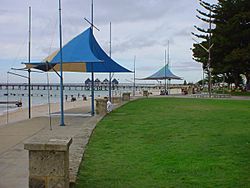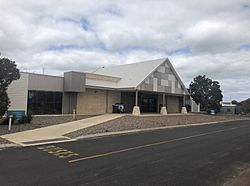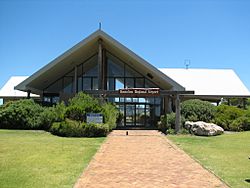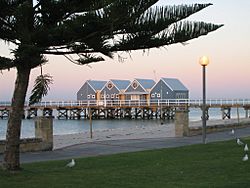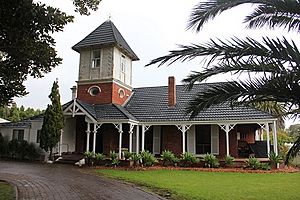Busselton facts for kids
Quick facts for kids BusseltonWestern Australia |
|||||||||
|---|---|---|---|---|---|---|---|---|---|
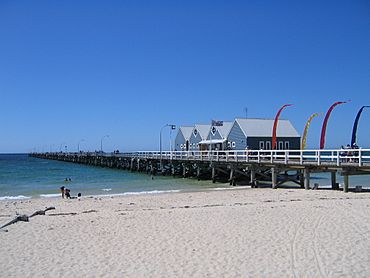
At 1,841 metres (6,040 ft), the Busselton Jetty is the longest wooden jetty (pier) in the Southern Hemisphere
|
|||||||||
| Population |
|
||||||||
| • Density | 239.63/km2 (620.6/sq mi) | ||||||||
| Established | 1832 | ||||||||
| Postcode(s) | 6280 | ||||||||
| Elevation | 4 m (13 ft) | ||||||||
| Area | 105.7 km2 (40.8 sq mi) | ||||||||
| Time zone | AWST (UTC+8) | ||||||||
| Location |
|
||||||||
| LGA(s) | City of Busselton | ||||||||
| State electorate(s) | Vasse | ||||||||
| Federal Division(s) | Forrest | ||||||||
|
|||||||||
Busselton is a city in the South West region of the state of Western Australia approximately 220 km (140 mi) south-west of Perth. Busselton has a long history as a popular holiday destination for Western Australians; however, the closure of the Busselton Port in 1972 and the contemporaneous establishment of the nearby Margaret River wine region have seen tourism become the dominant source of investment and development, supplemented by services and retail. The city is best known for the Busselton Jetty, the longest wooden jetty in the Southern Hemisphere.
Contents
History
European settlement
The early history of European exploration of the Busselton area focuses on the French expedition of 1801 which brought Nicholas Baudin, with his ships the Géographe and Naturaliste, to the coast of Western Australia. Baudin named Geographe Bay and Cape Naturaliste after his vessels, and named the river Vasse after a sailor, Thomas Vasse, who was lost as he went overboard and believed to have drowned.
Busselton was one of the earliest settlements in Western Australia. It was first settled by the Bussell family, who relocated there from their location on the Blackwood River after John Garrett Bussell discovered superior farm land in the area. The Bussells moved to the area in 1834, establishing a cattle station which they named Cattle Chosen. Cattle Chosen quickly became one of the most prosperous stations in the colony, and as a result nearly all of the settlers at Augusta relocated to the area within a few years. A number of settlers established themselves at Wonnerup, and eventually a contingent of troops were stationed there under Lieutenant Henry Bunbury. It was originally intended to locate the townsite at Wonnerup, but the area was low-lying and marshy, and Bunbury considered it unsuitable for a townsite. The present area was then recommended by the Surveyor General, John Septimus Roe.
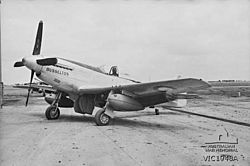
The present name of Busselton derives from the Bussell family. It was first officially used in June 1835. The Bussells, who were not consulted about the name, preferred the name Capel after a relative in England, Capel Carter, but the name Busselton was retained. A town named Capel was later established to the north of Busselton.
Being in close proximity to the tall timber country, Busselton soon established itself as a leading port. In 1850, timber was being exported and the small town prospered. Jetties for this purpose were built at Wonnerup, Busselton and Quindalup. Of these, only the Busselton Jetty remains.
During World War II 476 Busselton born men signed up for service; 20 in the Royal Australian Navy, 110 in the Royal Australian Air Force and 346 in the Australian Army. The names of the fallen are displayed on the towns war memorial alongside those of World War I in St Marys Park. During the war Busselton was home to an Air Force training base - remains of the base can still be seen today from the Busselton Bypass Road. A Royal Australian Air Force P-51 Mustang fighter was given the nickname Busselton in honour of the people of Busselton and their support of War Loan fundraising activities.
Railways
Western Australia's first railway line was built just north of Busselton at Lockville in 1871, the original engine known as the Ballarat engine is on display near the tourist bureau. The privately owned line was used for the transport of timber to the Wonnerup jetty across the Ballarat bridge which was later converted to a pedestrian bridge and removed in 2004 to allow for the replacement of the nearby Vasse Floodgates.
From about 1927 to 1957, Busselton was also on the WAGR railway line running from Bunbury to Flinders Bay.
Following the closure in the 1950s of the Flinders Bay branch, most of the old line formation was changed in ownership. The railway line also connected onto the Busselton Jetty and was not closed on the jetty until the 1970s.
The connection with Bunbury was closed in the late 1980s.
Transport
Bussell Highway links Busselton with Bunbury and Augusta, while Vasse Highway goes from Busselton to Pemberton and beyond. Caves Road provides an alternative scenic route from Busselton to Augusta; Sues Road is another alternative route via the Brockman Highway.
Busselton has a town bus service run by Swan Transit South West (TransBusselton), with three routes. South West Coach Lines and Transwa provide coach services for connections to other south west towns and Perth. Busselton is served by Busselton Margaret River Airport.
Climate
Busselton experiences a Mediterranean climate (Köppen climate classification Csa/Csb). Residents and visitors enjoy moderate temperatures, with an average maximum temperature of 22 °C and a minimum of 11 °C. The summers are generally hot, with an average daily maximum of 28 °C (82.4 °F) with cooling afternoon sea breezes, and a winter that delivers cooler temperatures; 8 to 18 °C (46.4 to 64.4 °F) and rain that supports diverse agricultural industries, including a world-famous grape-growing region. The annual average rainfall for Busselton is 864 mm, with the wettest period being from May to September.
| Climate data for Busselton | |||||||||||||
|---|---|---|---|---|---|---|---|---|---|---|---|---|---|
| Month | Jan | Feb | Mar | Apr | May | Jun | Jul | Aug | Sep | Oct | Nov | Dec | Year |
| Record high °C (°F) | 38.9 (102.0) |
39.9 (103.8) |
37.3 (99.1) |
33.0 (91.4) |
27.9 (82.2) |
22.2 (72.0) |
21.0 (69.8) |
21.3 (70.3) |
27.7 (81.9) |
32.7 (90.9) |
34.4 (93.9) |
37.1 (98.8) |
39.9 (103.8) |
| Average high °C (°F) | 29.3 (84.7) |
29.3 (84.7) |
27.3 (81.1) |
23.5 (74.3) |
20.6 (69.1) |
18.2 (64.8) |
17.1 (62.8) |
17.5 (63.5) |
18.4 (65.1) |
20.9 (69.6) |
24.3 (75.7) |
27.1 (80.8) |
22.8 (73.0) |
| Average low °C (°F) | 14.8 (58.6) |
15.5 (59.9) |
14.1 (57.4) |
11.8 (53.2) |
10.4 (50.7) |
8.8 (47.8) |
8.0 (46.4) |
8.3 (46.9) |
8.9 (48.0) |
9.7 (49.5) |
11.9 (53.4) |
13.2 (55.8) |
11.3 (52.3) |
| Record low °C (°F) | 6.8 (44.2) |
7.9 (46.2) |
4.7 (40.5) |
4.3 (39.7) |
2.3 (36.1) |
0.4 (32.7) |
0.9 (33.6) |
1.2 (34.2) |
2.1 (35.8) |
3.7 (38.7) |
3.3 (37.9) |
5.2 (41.4) |
0.4 (32.7) |
| Average precipitation mm (inches) | 14.6 (0.57) |
4.0 (0.16) |
11.3 (0.44) |
40.4 (1.59) |
93.8 (3.69) |
133.6 (5.26) |
140.8 (5.54) |
113.0 (4.45) |
80.7 (3.18) |
33.5 (1.32) |
25.0 (0.98) |
9.6 (0.38) |
704.6 (27.74) |
| Average precipitation days | 2.9 | 2.5 | 4.4 | 9.4 | 13.5 | 17.0 | 19.6 | 18.9 | 16.4 | 10.0 | 6.7 | 3.8 | 125.1 |
| Average relative humidity (%) | 43 | 44 | 48 | 56 | 62 | 66 | 67 | 65 | 62 | 56 | 50 | 44 | 55 |
| Source: Australian Bureau of Meteorology | |||||||||||||
Demographics
The 2016 Australian census recorded Busselton's population as 25,329, 69.0% of the population of the City of Busselton local government area, which was 36,686. The 2016 census also recorded Busselton's median age as 42, higher than the national average of 38. Australian-born residents made up 74.7% of Busselton's population, followed by those born in England (7.7%), New Zealand (2.5%), South Africa (1.0%), Scotland (0.7%), and the Philippines (0.5%). English was the only language spoken at home by 88.4% of residents, with the next most common languages being German and Afrikaans (0.4%), Italian and Hazaragi (0.3%), and Tagalog (0.2%). The most common industry for employed people in Busselton was listed as "accommodation" at 4.1%, compared to the national average of 1.1%; others were "supermarket and grocery stores" (3.4%), aged care residential services (3.1%), "cafes and restaurants" (3.0%), and "primary education" (2.6%).
As at June 2018 the estimated population of the Busselton statistical area was 27,584, having increased by 1.2% in the preceding 12 months. It has been estimated that by 2050 Busselton's population will be between 50,000 and 70,000, with the local government area containing between 70,000 and 100,000 people.
Facilities
Airport
Busselton is serviced by Busselton Regional Airport.
Schools
Primary schools in the Busselton area include Busselton Primary, West Busselton, Cornerstone Christian College, Dunsborough Primary, Geographe Primary School and Education Support Centre, Georgiana Molloy Anglican School, Our Lady of the Cape, St. Joseph's, and Vasse Primary.
High schools in the area include Busselton Senior High School (years 8-12), MacKillop Catholic College (years 8-12), Cornerstone Christian College (years K-12), Georgiana Molloy Anglican School (years K-12), Cape Naturaliste College (years 8-12).
The only tertiary institution in the area is the South Regional TAFE.
Hospital
Busselton District Hospital is located 3 km west of the town centre.
A new hospital has been announced by the State Government, with completion expected in 2014. Facilities of the new hospital will include 64 overnight and 20 same-day beds, a new renal unit, two operating and an expansion of the Emergency Department.
Recreation and culture
Events
Events are held year round in Busselton. The most notable being:
- Southbound Music Festival in January
- Busselton Beach Festival
- CinefestOZ Film Festival
- Festival of Busselton
- Geographe Bay Race Week
- Busselton Festival of Triathlon
- Ironman Western Australia Triathlon Busselton
- The Busselton Jetty Swim
Places of worship
There are only Christian places of worship in Busselton. These include:
- Anglican St Mary's
- Assemblies of God (Abundant Life Centre Busselton)
- Baptist
- Church of Christ
- Hope
- Jehovah's Witnesses
- Potter's House
- Roman Catholic Our Lady of the Bay
- St Joseph's
- The Church of Jesus Christ of Latter-Day Saints
- The Salvation Army
- Seventh Day Adventist
Media
Busselton is serviced by two local weekly newspapers; the Busselton Dunsborough Mail (Wednesday) and the Busselton Dunsborough times (Friday). The West Australian is available from Monday to Saturday and the Sunday Times is available on Sundays.
Busselton is serviced by three commercial television channels, GWN7, WIN and Nine. The public broadcast channels ABC and SBS are also available.
Nearby cities
Although properly Busselton is the only city in its local government area (The Shire of Busselton), other important townships include Dunsborough, Yallingup, and Vasse.
The nearest city to Busselton is Bunbury, which is 53 km away.
Economy
The main industries of the Busselton area are services (e.g. retail, wholesale, manufacturing, and recreation). The economic focus of the region has gradually shifted from agriculture as the population has increased and tourism has grown in the district.
Tourism
Many sites of interest are in the Busselton region. Busselton Beach is known for the turquoise-coloured, tranquil waters and white sands.
Busselton Jetty
Busselton is home to the longest wooden jetty (pier) in the Southern Hemisphere, stretching 1,841 metres (6,040 ft) out to sea. Construction of the jetty began in 1864 and it was continually extended until the 1960s, when it reached its current length. It was closed to shipping in 1972, and maintenance was discontinued for a time. Following major damage caused by Cyclone Alby in 1978 and a fire in 1999, it was restored and improved. Since 2003, the jetty has offered visitors a tourist train ride, an underwater observatory, and an interpretive centre.
Wonnerup House
The current Wonnerup House was built in 1859 by the Layman family (original settlers). The original building built between 1837 and 1841 was destroyed by fire in 1858. The complex also includes the dairy and kitchen, which antedate the main house (and survived the fire of 1858 because they were separate buildings). Over the road are the Teacher's House (1885) and School (1873). Since 1973, the National Trust of Australia has operated the property as a museum open to the public.
Old Butter Factory/Busselton Museum
The Old Butter Factory was built in 1918 by the government Department of Agriculture to replace a previous privately owned dairy, Western Australia's first butter factory and creamery, that was established in 1898. In 1926 the factory was sold to South-West Dairy Produce Co-operative, which was later renamed "Sunny West" and merged into Wesfarmers. The factory also operated as an ice works for local residents and fishermen before the widespread availability of mechanical refrigeration. It ceased butter-making operations in 1952 and became a cream depot and dried milk plant, then a truck depot. In 1974 it was sold to the Shire of Busselton, which leased most of the building to the Busselton Historical Society; they opened the Busselton Museum there in 1975. It was listed on the state's Register of Heritage Places in 2002. In March 2018, the building was heavily damaged by fire. the outside areas were re-opened in January 2019 and the rest of the building was opened in December 2020.
St Mary's (Church of England)
St Mary's (Church of England), built in 1844–1845, is allegedly the oldest stone church in Western Australia. John Molloy and John Garrett Bussell were the main forces behind the construction of the church. The church was not consecrated until 1848 and a clergyman was not attracted to the region for another decade. Alongside the church is a graveyard; some of the graves date back to 1841 – before the building of the church.
Ithaca (Villa Carlotta)
Ithaca (formerly known as Villa Carlotta) is located at 110 Adelaide St, Busselton, and was built by Frank Backhouse in 1896. Ithaca is listed on the state's Register of Heritage Places in recognition of its significant historical and community values. Ithaca has a two-storey tower and was originally built as a private residence; in 1904, Ithaca was acquired by Sisters of Our Lady of the Missions for use as a Catholic convent. Subsequently, it has been a school and a hotel, and now is a motel.
Weld Hall
Weld Hall located on the corner of Queen and Adelaide St was built in 1881. In August 2001, the Western Australian government announced that Weld Hall had been listed on the Register of Heritage Places in recognition of its significant historical and cultural value to the local community. The hall is a single-storey brick building with a galvanised roof, and is constructed in a simplified Victorian Italianate style; it is one of the oldest remaining structures in the town.
Augusta-Busselton Heritage Trail
The trail retraces the Pioneer Route from Augusta to Busselton taken by the original settlers in the 1800s. It is over 100 km long, starting at the jetty and finishing in Augusta.
Notable people
- Stewart Bovell, politician
- Sharon Buchanan, hockey player, Olympic gold medallist
- Taj Burrow, surfer
- John Bussell, founder of Busselton
- Kevin Cullen, doctor and winemaker
- Edmund Drake-Brockman, soldier, statesman, and judge
- Joseph Strelley Harris, pastoralist, Busselton's second magistrat
- Barry House, politician
- Sean Keenan, actor
- Georgiana Molloy, early settler, botanical collector
- John Molloy, early settler, Busselton's first magistrate, husband of Georgiana Molloy
See also
 In Spanish: Busselton para niños
In Spanish: Busselton para niños



